The Old Guard
August 6, 2024Livestock Protection Dogs are the unsung heroes of Texas agriculture
BY: LAUREL MILLER
While horses and cattle are indisputably central characters in Texas history, myth, and lore, livestock protection dogs (LPD, or LGD, livestock guardian dogs) might well be considered the unsung heroes of the ranch and range. These large (80-120 pounds) canines originated in the Fertile Crescent some 4,000 years ago, when nomadic shepherds bred them to protect their sheep and goats from predators like bears, wolves, and big cats.
Even today, parts of Europe and Asia produce guardian breeds, like the Great Pyrenees, Maremma, Anatolian, Kangal, and Akbash. These dogs first came to the United States in the 1970s, but according to longtime Kangal/Akbash breeder Tamara Taylor of Patteran Dairy Goats in Era, Texas, “Flock guardian dogs were likely introduced by the Spaniards in the 16th century. All of these ancient dogs were types, and because there was no record keeping back then, it’s not possible to trace a specific breed’s origins.”
These early dogs were tasked with guarding the flocks of sheep, goats, and cattle herded through wild territory and then raised on the missions. At that time, predators were rampant, and the dogs, says Taylor, “were allotted the same pay as the herdsman. It was an Old World solution to a New World problem.”
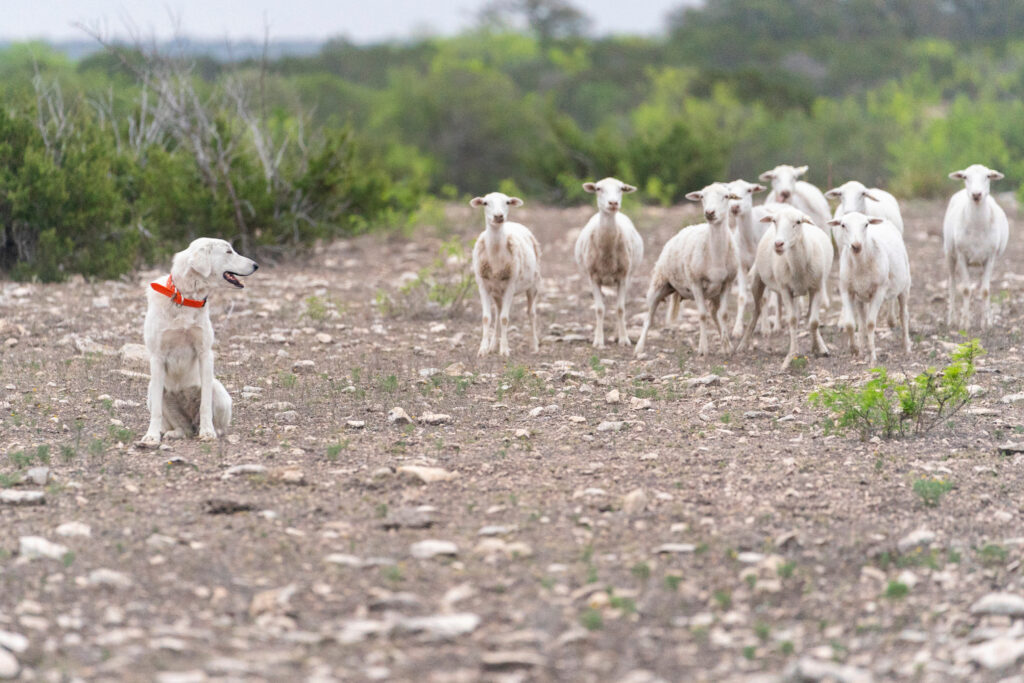
While LPD’s primary role is to protect their charges, they are considered a non-lethal form of predator control. The dogs are typically white, so they blend in with their charges and don’t stand out to predators. Unlike herding dog breeds, whose job is to control the movement of livestock under command, LPD’s live outdoors year-round and work unsupervised, says Bill Costanzo, LGD Extension Program Specialists at Texas A&M AgriLife Center in San Angelo. Some breeds, like Anatolian Shepherds, tend to patrol perimeters, while others, like the Italian Maremma, stick close to the livestock.
“LPD’s perceive the environment so differently than we do,” says Taylor. These dogs have all been genetically preselected for traits like watchfulness.
Tamara Taylor, Patteran Dairy Goats
They’ll often position themselves on high ground, like a roof, hill, or bale of hay, so they have a better vantage point.”
The stalwart presence of LPD’s on ranches and farms is meant to deter threats, including other dogs. But, if a predator continues to challenge (the herd or flock), “an LPD will kill it,” says Costanzo. “Prey drive is the instinctive inclination of a carnivore to find, pursue, and capture prey. That instinct has been bred out of LPD’s for thousands of years, unlike herding and hunting dogs, but they still require proper socialization, bonding with livestock, and training until they reach maturity at 18 to 24 months of age.”
Guardian dogs also perform a different function from ranch dogs, says Amelia Sweethardt, an award-winning, second-generation cheesemaker at Pure Luck Farm & Dairy in Dripping Springs. “Ranch dogs aren’t necessarily well-socialized, but LPD’s need to be, as well as bite- averse. We have the public out for tours, and we can’t have dogs that jump, bite, or bark.”
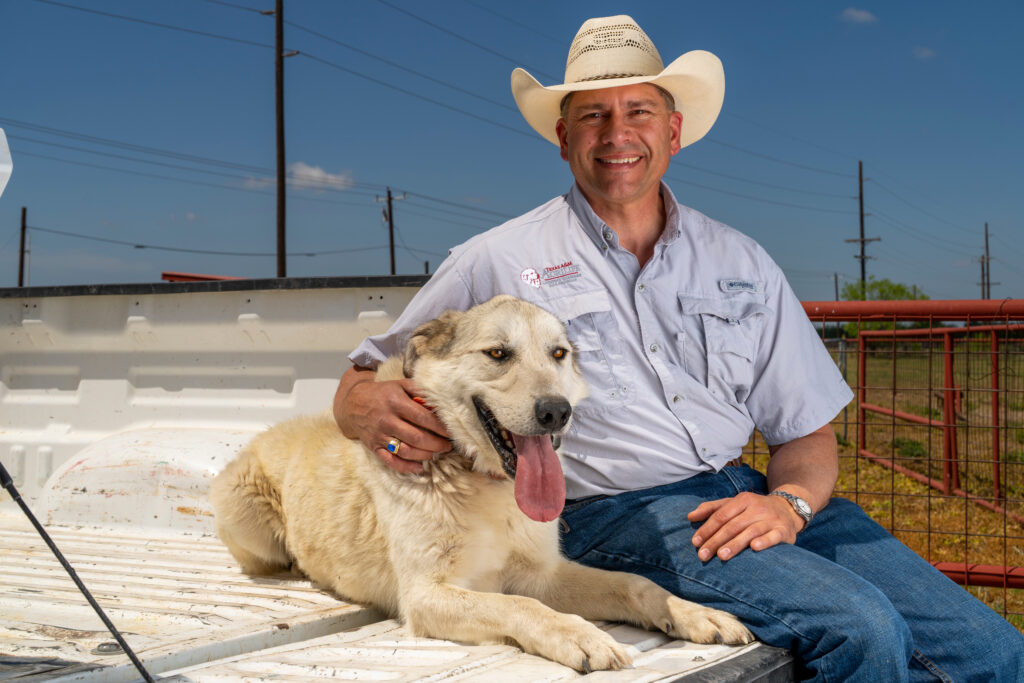
Proper training, as well as secure fencing are paramount to an LPD’s success. “A lot of older ranchers don’t want dogs on their property at all because they’re predators, so if they see a loose LPD on their land, they’re likely to shoot it,” says Costanzo. “Other hazards to loose dogs are cars, snares, poison, and other dogs. Bonding and training in hot wire pens is the most effective deterrent to roaming, along with using invisible fences when training of older pups, followed by neutering and spaying.”
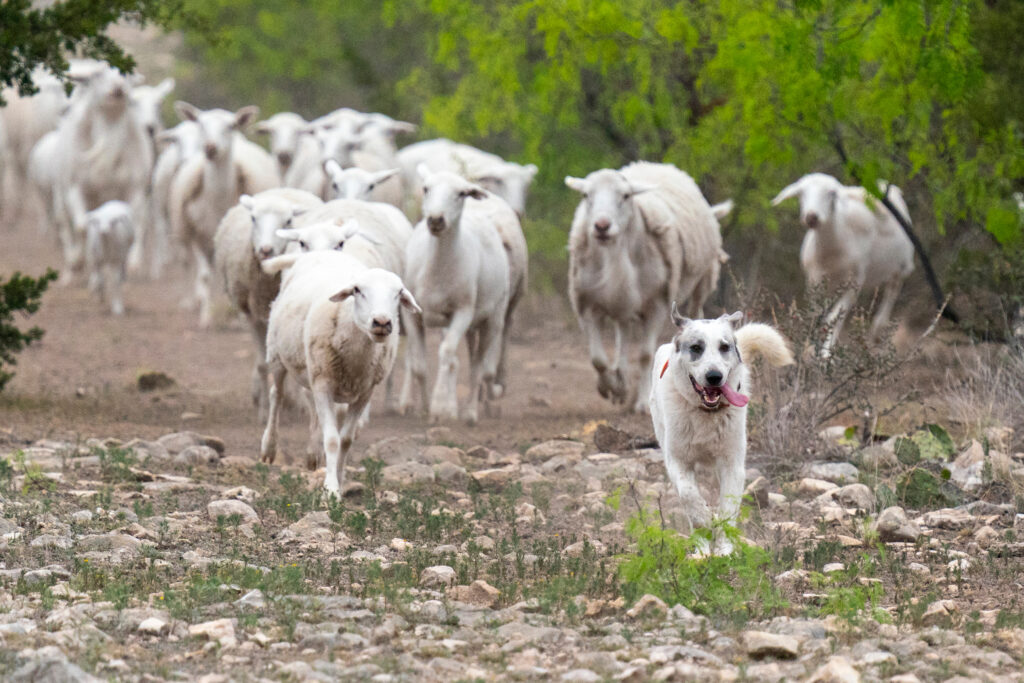
WORKING LIKE A DOG
Texas A & M’s LPD research programming was created in 2016, in response to the increased demand for guardian dogs amongst sheep and goat producers. The nation’s greatest concentration of these producers are located on the Edwards Plateau and the Panhandle, where much of the agricultural land is unsuitable for crops or cattle. Costanzo notes that in the Panhandle, LPD’s are even used on cattle feedlots to deter other dogs.
“Predators are out of control in Texas,” says Costanzo. “It’s a huge state and there’s only so much you can do using non-lethal measures.” He cites issues like feral hogs, which prey upon ranch lamb and kid crops, which are born on the range amid dense brush, making it difficult for dogs to control predators.
Predation accounts for billions of dollars in losses every year for American livestock producers, but, says Costanzo, the last USDA study on LPD effectiveness, conducted in 2020, showed that ranchers who use guardian dogs cut their annual livestock predation losses from 10 to 20-percent, to zero.
Costanzo oversees the Livestock Guardian Dog Bonding Project, which was implemented in 2019 to improve best-management practices for LPD’s and their owners. “You need to adjust your practices to suit the dogs, and set them up for success,” he says. “Take pastured poultry. LPD’s are growing more popular with homesteading operations, but birds tend to be excitable and flap around, so it’s critical to choose a breed with a soft mouth, like a Pyrenees, and habituate them when they’re pups by keeping them in a pen placed inside the poultry area, surrounded by tame birds.”
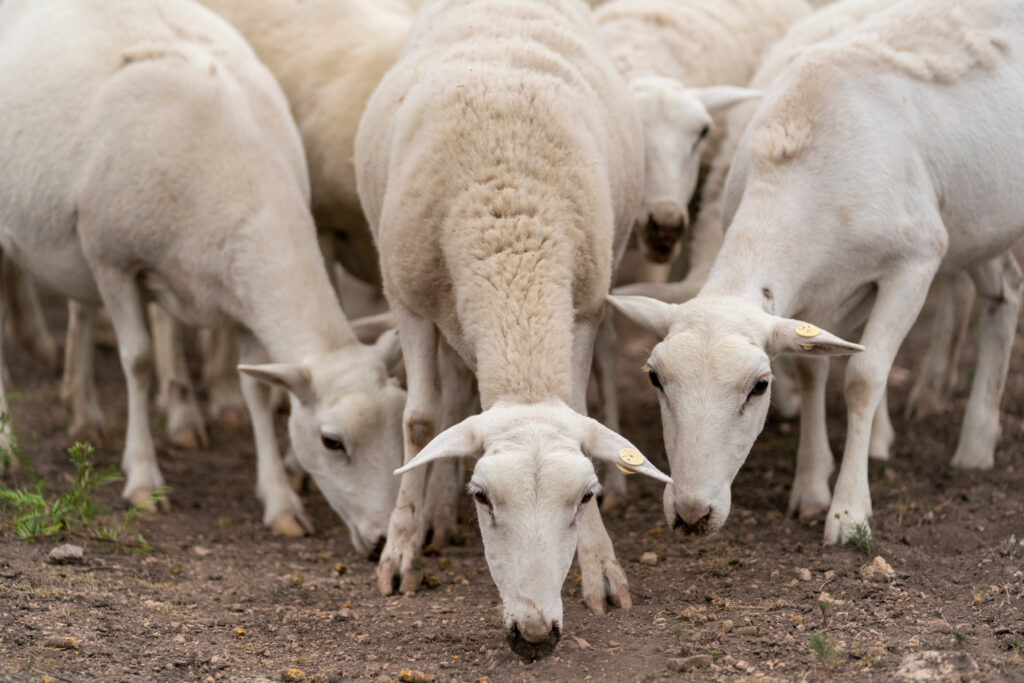
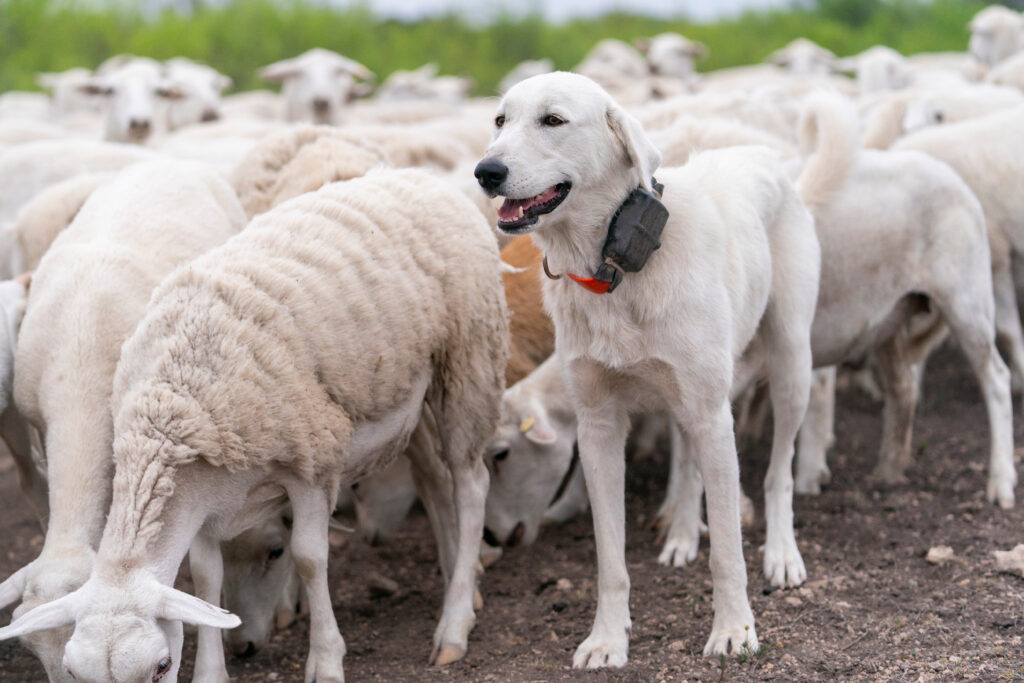
The mercurial Texas climate can also be challenging for LPDs, which are double- or triple-coated, meaning they have dense undercoats and stiff outer hairs that repel moisture or insulate the animals in extreme temperatures. Costanzo recommends short-haired breeds like Akbash or Anatolians, especially in high-humidity regions like East Texas. Long-haired breeds require proper grooming for adequate protection from the elements.
Some ranchers and farmers purchase crossbred LPD’s, something Costanzo and other experts discourage. “Purebred LPD’s are very expensive [wean puppies start at $400, while a trained adult dog runs around $1,500], so it’s an investment,” he says. “Some producers want a dog that does it all- guards livestock, humans, and the home, and that’s not what LPD’s are for. Every breed has a tendency for something, and what we’ve seen anecdotally from our research is that sometimes you get the worst of both breeds, not the best. I’m trying to encourage livestock producers to buy pure genetics, choosing breeds that are a fit for their respective operations.”
AT HOME ON THE RANGE
Commercial small ruminant ranching in Texas took off in the 18th century, and today Texas is the nation’s leading producer of sheep and meat goats- species that were also introduced by the Spaniards. The establishment of ranches, followed by the invention of barbed wire fencing and increases in population and urbanization largely eradicated predators in Texas until the late 1970s.
“That’s when these massive old family ranches started being sold and subdivided into 100-acre tracts for hobby farms and hunting leases,” says Costanzo. “The subsequent lack of agricultural production, and game stocking or feeding led to a surge in predators, and that’s why LPD’s were introduced not just to Texas, but the US.”
It should be noted that unlike their historical use, where LPD’s worked in tandem with shepherds, modern guardian dogs work unsupervised. Meat goats and sheep are typically raised on fenced ranges, and kid and lamb in high grass or brush, which makes them vulnerable to avian predators like black vultures and caracaras, who spot prey from the air. Conversely, dairy small ruminants give birth in confined, protected spaces.
“Dairy goats are different from ranch (meat) goats because female dairy animals are raised for long haul production,” says Sweethardt. “Ranch goats live off the land and aren’t managed, while dairy animals have very specific feed requirements and need to be hand raised to ensure they’re able to be milked.”
Sweethardt’s mother, the late Sara Sweetser, established Pure Luck’s dairy operation in 1995, but the family got their first LPD a decade earlier. While the region has its predators- namely bobcats, coyotes, and vultures- domestic dogs pose the biggest threat. “Before my mom started the dairy, she was attacked by a neighbor’s Lab that also ripped the necks out of some of our goats. That’s when we got our first dog, a Pyrenees,” says Sweethardt.
Today, Pure Luck has three LPD’s. “We haven’t lost any animals since that initial attack, but recently we’ve had a bobcat killing deer in our front yard. Our junior goats are the same size, which is why we have tight fencing around the dairy to keep predators out, and our animals, including the dogs, in.” Sweethardt notes that her backyard is also fenced off with hot wire, to keep Pure Luck’s LPD’s out.
“There have to be clear boundaries” she says, “If you bring LPD’s into the house or yard, they won’t do the job they’re supposed to do because they don’t understand what their territory is. Our dogs oversee the dairy, and we don’t allow anyone to bring dogs on the property, because our LPD’s need to view all canines as a threat.”
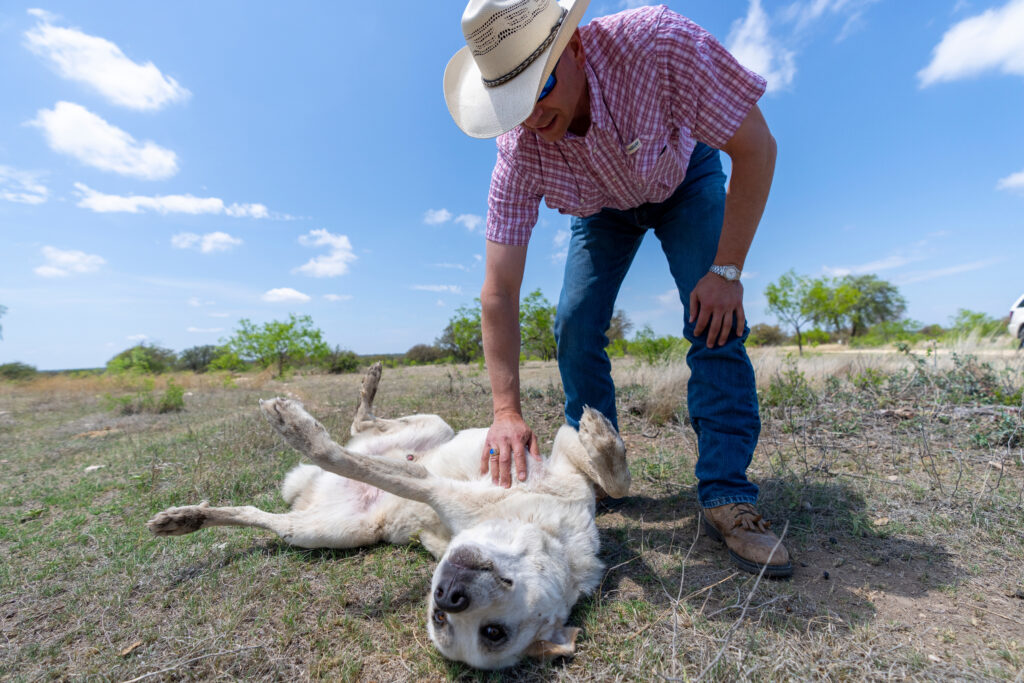
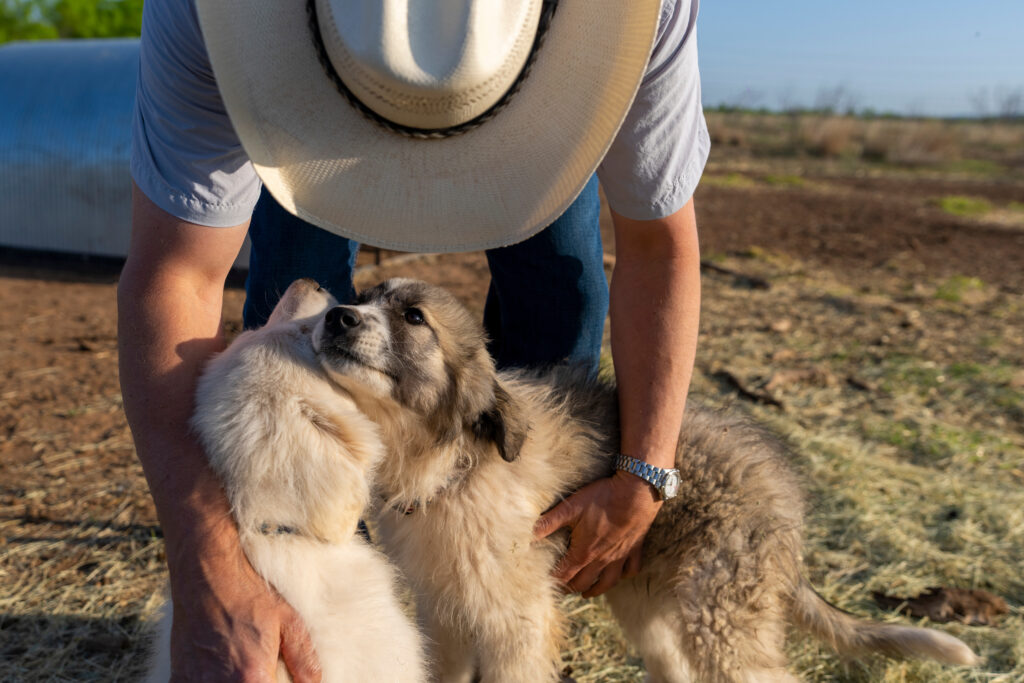
The Taylor’s got their first LPDs in 1980, shortly after they purchased their initial dairy goats. “The second we had goats, we got predators, and then our neighbor’s dogs killed our rabbits, so our veterinarian recommended we get a livestock protection dog,” says Taylor, who also raises sheep with her husband, Mike. The couple’s first dogs were Akbash, a Turkish breed that can reach 140 pounds. The dogs came from Dan and Judy Nelson, who imported the first Akbash dogs into the US in 1978.
Known for their majestic appearance and what Taylor calls a “charming” demeanor, Akbash’s are popular with small ruminant producers because they’re vigilant and protective, but not aggressive. The Taylors also raise Kangal’s, another Turkish breed that is “big, and capable of taking on big predators, if necessary,” says Taylor, “If there’s an invitation to the dance, a Kangal won’t turn it down.”
With more than 80 years’ combined experience with LPD’s, it’s not surprising that Taylor and Sweethardt consider their dogs business partners, integral to the success of their respective livestock operations.
“They aren’t for everyone,” says Taylor. “Some people don’t have the patience or desire to understand them or undertake the process of properly training them, but by preventing predators from harming our livestock, our dogs have paid for themselves. Even more valuable is the peace of mind they provide, whether we’re off the ranch or sound asleep.
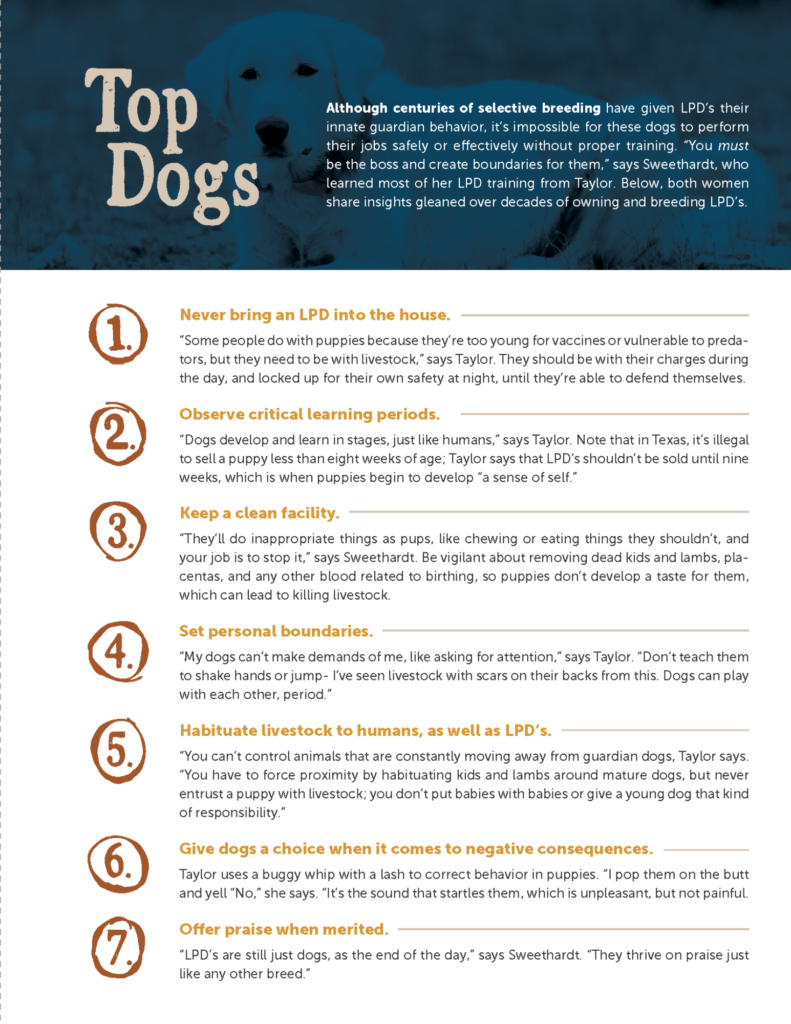
Photos: Livestock Guardian Dog Program on Tuesday, Apr 18, 2023 in San Angelo, Texas. (Michael Miller/Texas A&M AgriLife Marketing and Communications)